12 more glaciers that haven’t heard the news about global warming
ihatethemedia.com
January 25 2010
The glaciers are melting! The glaciers are melting! The glaciers are…uhhhhh…never mind.
Turns out the IPCC’s chicken little story that all the Himalayan glaciers are melting is just another exaggeration. Or fraud. Take your choice. You know, like the stats coming out of East Anglia CRU. And its claim that Antarctica is melting. And that Greenland’s ice cap is melting. And that sea levels are rising. And that the polar bears are dying. Fact is, some glaciers are retreating, but many others around the world are growing.
“But how is that possible? How can glaciers be growing when the world is warming up like a package of Jiffy-Pop in a microwave?”
Here are a dozen glaciers (or groups of glaciers) around the world that are growing almost as quickly as global warming skepticism.
1. Himalayan glaciers are growing, not shrinking
Things are not as they seemed to be in the IPCC report. Not only are the Himalayan glaciers not shrinking, they’re growing. Discovery reports:
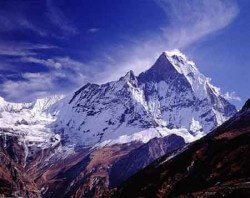
Perched on the soaring Karakoram mountains in the Western Himalayas, a group of some 230 glaciers are bucking the global warming trend. They’re growing. Throughout much of the Tibetan Plateau, high-altitude glaciers are dwindling in the face of rising temperatures. The situation is potentially dire for the hundreds of millions of people living in China, India and throughout southeast Asia who depend on the glaciers for their water supply.
But in the rugged western corner of the plateau, the story is different, according to a new study. Among legendary peaks of Mt. Everest like K2 and Nanga Parbat, glaciers with a penthouse view of the world are growing, and have been for almost three decades.
“These are the biggest mid-latitude glaciers in the world,” John Shroder of the University of Nebraska-Omaha said. “And all of them are either holding still, or advancing.”
Source: Discovery
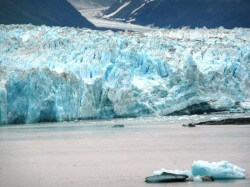 2. Alaska’s Hubbard Glacier. Growing. A lot.
2. Alaska’s Hubbard Glacier. Growing. A lot.
Alaska’s Hubbard Glacier is advancing moving toward Gilbert Point near Yakutat at an average of seven feet per day.
The Army Corp of Engineers’ Hubbard Glacier website for has some great photos of the advancing behemoth.
Source: CDApress.com
3. Norwegian glaciers. Growing again.
IceAgeNow.com reports on the growth of Norwegian glaciers:

“After years of decline, glaciers in Norway are again growing, reports the Norwegian Water Resources and Energy Directorate. The actual magnitude of the growth, which appears to have begun over the last two years, has not yet been quantified, says NVE Senior Engineer Hallgeir Elvehøy.”The developments were originally reported by the Norwegian Broadcasting Corporation (NRK).
Source: IceAgeNow.com
4. Glaciers growing on Canada’s tallest mountain
Canada.com tells the tale of glaciers growing on Canada’s tallest mountain:
“Canada’s tallest mountain, the Yukon’s towering Mount Logan, may have experienced a growth spurt.
“The University of Alaska aerial survey, conducted last summer with a laser altimeter by Fairbanks-based geoscientist Sandy Zirnheld, pegged Canada’s geographic zenith at 5,966 metres. That’s seven metres (23 feet) higher than the official height of 5,959 metres, determined in 1992 after a celebrated climb to the top by a team of Canadian researchers led by Mike Schmidt of the Geological Survey of Canada.
“Snow and ice accumulation is the most likely explanation,” Chris Larsen, the scientist leading the University of Alaska’s research on the continent’s northwest mountain ranges, said.”
Source: Canada.com
5. North to Alaska and more growing glaciers
Alaska’s glaciers have been in retreat for nearly 200 years. But now they’re advancing again.
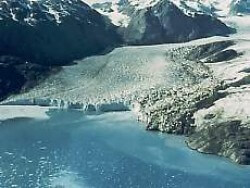 MichNews.com reports the cold, hard facts:
MichNews.com reports the cold, hard facts:
“Unusually large amounts of Alaskan snow last winter were followed by unusually chilly temperatures there this summer. “In general, the weather this summer was the worst I have seen in at least 20 years,” says Bruce Molnia of the U.S. Geological Survey, and author of The Glaciers of Alaska. “It’s been a long time on most glaciers where they’ve actually had positive mass balance (added thickness).”
“Overall, Molnia figures Alaska had lost 10–12,000 square kilometers of ice since 1800, the depths of the Little Ice Age. That’s enough ice to cover the state of Connecticut. Climate alarmists claim all the glaciers might disappear soon, but they haven’t looked at the long-term evidence of the 1,500-year Dansgaard-Oeschger climate cycles. During the Little Ice Age—1400 to 1850—Muir Glacier filled the whole of Glacier Bay. Since then, the glacier has retreated 57 miles.
Source: MichNews.com
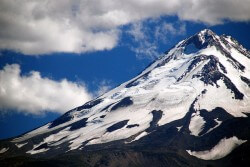 6. Glaciers are growing in California. California?
6. Glaciers are growing in California. California?
You might be surprised to learn that the Golden State has glaciers. And the Associated Press says they’re growing:
“Global warming is shrinking glaciers all over the world, but the seven tongues of ice creeping down Mount Shasta’s flanks are a rare exception: They are the only known glaciers in the continental U.S. that are growing.”
Source: FoxNews.com
7. A glacier is growing on Washington’s Mt. St. Helens.
Mount Saint Helens has glaciers? But it’s an active volcano. But, but, but…
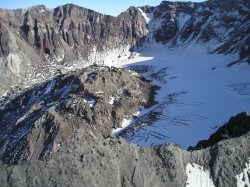 KATU-TV reports the details:
KATU-TV reports the details:
“On May 18, 1980, the once bucolic ice-cream cone shape that defined Mount St. Helens in Washington state disappeared in monstrous blast of ash, rock, gas, and heat.
“Inside the volcano, which was once a soft dome of snow but is now a gaping, steaming menace with an unpredictable streak, an unexpected phenomenon is taking place: a glacier is growing.
“In these days of global warming concerns and scientists showing alarming then-and-now images of glaciers disappearing from mountainsides, it may be the only growing glacier in America – or maybe the world.
Source: KATU.com
8. Glaciers are growing in France and Switzerland, too
Another continent has reported in. According to an article in the Journal of Geophysical Research, glaciers are growing in France and Switzerland, too:
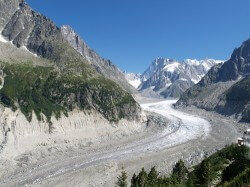
The research was conducted by six scientists from leading agencies and departments in France and Switzerland that deal with hydrology and glaciology. The research was funded by Observatoire des Sciences de l’Univers de Grenoble (OSUG), the European Programs ALPCLIM and CARBOSOL, and by the city of Chamonix Mont-Blanc.Vincent et al. collected a variety of datasets that could help them understand how the high-elevation glaciers of Mont Blanc were impacted by variations and trends in climate. Among other findings, they found that the mass balance of the glaciers is strongly controlled by precipitation, not temperature.
Vincent et al. state “The most striking features of these figures are the small thickness changes observed over the 20th century. For both areas, thickness variations do not exceed ±15 m. The average changes are +2.6 m at Dôme du Goûter (please note that this glacier is growing) and -0.3 m (-12 inches) at Mont Blanc.
“Considering the uncertainty interval, i.e., ±5 m, it can be concluded that no significant thickness change is detectable over most of these areas”. “All these results suggest that the SMBDôme du Goûter and Mont Blanc did not experience any significant changes over the 20th century.”
Source: World Climate Report
9. New Zealand’s largest glaciers are growing
Growing may not be a strong enough word. They’re surging. IceAgeNow.com reports the story:
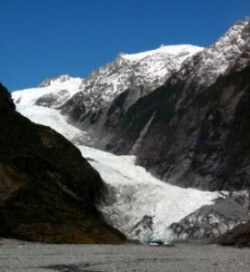
Guides say the Franz Josef and the Fox glaciers continued advancing down their valleys in the past year and may soon be close to positions reached 40 years ago.
That (supposedly) contrasts sharply with the plight of many glaciers elsewhere on the planet, which are (supposedly) shrinking three times faster than they were in the 1980s, according to the World Glacier Monitoring Service (WGMS).
…
Franz Josef Glacier Guides base manager Tom Arnold estimated the Franz Josef and the Fox had advanced hundreds of meters in the past year.
Source: IceAgeNow.com
10. Russia’s glaciers are growing, too
The Russians don’t believe the IPCC forecasts, but they do believe their own eyes.
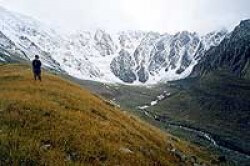
In 2002, a 22-million ton piece of ice broke off the gigantic Maili Glacier and crashed down a steep gorge into the village of Kami. It killed more than 150 people and injured hundreds more.The 500-foot wall of ice had been growing for six years. The Maili Glacier is just one of several glaciers in the North Caucasus Mountains that have been expanding at an alarming rate.
Other towns in the region have been partially buried by these advancing walls of ice. One local scientist in southern Russia said, “We may be seeing the beginning of a new great ice age!!!”
Source: IceAgeNow.com
11. Argentina’s Perito Moreno glacier is, you guessed it, growing
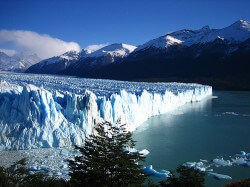 Is there a continent where glaciers aren’t growing? If so, South America isn’t one of them. Consider Argentina’s Perito Moreno glacier:
Is there a continent where glaciers aren’t growing? If so, South America isn’t one of them. Consider Argentina’s Perito Moreno glacier:
Nourished by Andean snowmelt, the glacier constantly grows even as it spawns icebergs the size of apartment buildings into a frigid lake, maintaining a nearly perfect equilibrium since measurements began more than a century ago.
“We’re not sure why this happens,” said Andres Rivera, a glacialist with the Center for Scientific Studies in Valdivia, Chile. “But not all glaciers respond equally to climate change.”
Source: IceAgeNow.com
12. Iceland’s Breidamerkurjokull glacier. Yup, it’s growing, too.
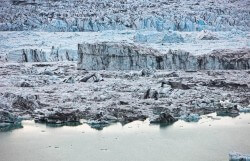 The Daily Mail UK ran a story on July 31, 2009 about the horrors of global warming. It was accompanied, for some inexplicable reason, by contradictory photos that showed the remarkable growth of Iceland’s Breidamerkurjokull glacier.
The Daily Mail UK ran a story on July 31, 2009 about the horrors of global warming. It was accompanied, for some inexplicable reason, by contradictory photos that showed the remarkable growth of Iceland’s Breidamerkurjokull glacier.
Their headline screamed, “How global warming is changing the face of the northern hemisphere.” The photos and caption told a story that was, you’ll pardon the expression, the polar opposite of what the article described.
Source: Daily Mail UK

